Numerical Study on Thermal and Flow Characteristics of Divergent Duct with Different Rib Shapes for Electric-Vehicle Cooling System
Abstract
:1. Introduction
2. Numerical Method
2.1. Computational Geometry
2.2. Meshing
2.3. Governing Equations
2.4. Boundary Conditions
2.5. Assumptions and Solution Procedure
2.6. Data-Reduction Equations
3. Results and Discussion
3.1. Validation
3.2. Thermal Characteristics
3.3. Flow Characteristics
3.4. Effect of Inlet Air Temperature
4. Conclusions
- (a)
- The maximum heat-transfer coefficients of 162.30 W/m2K, 177.87 W/m2K, 177.25 W/m2K, 180.65 W/m2K, 158.42 W/m2K, 172.87 W/m2K and 157.21 W/m2K and maximum Nusselt numbers of 540, 592, 590, 601, 527, 575 and 523 are evaluated as thermal characteristics for the rectangular, isosceles-triangular, left-triangular, right-triangular, trapezoidal, left-trapezoidal and right-trapezoidal rib shapes, respectively;
- (b)
- The flow characteristics of maximum pressure drops of 139.1 Pa, 154.52 Pa, 164.5 Pa, 137.3 Pa, 109.9 Pa, 142.5 Pa and 131.6 Pa and maximum friction factors of 0.038, 0.044, 0.047, 0.040, 0.034, 0.043 and 0.037 are evaluated for the rectangular, isosceles-triangular, left-triangular, right-triangular, trapezoidal, left-trapezoidal and right-trapezoidal rib shapes, respectively;
- (c)
- The heat-transfer coefficient, the Nusselt number and the pressure drop show increasing trends with the increase in the Reynolds number; however, there is a critical Reynolds number whereby the friction factor is maximum for all rib shapes;
- (d)
- The divergent duct with the right-triangular rib shape shows superior thermal characteristics in terms of maximum heat-transfer coefficient and maximum Nusselt number. The flow characteristics of pressure drop and friction factor of right-triangular ribs are higher than those of the trapezoidal and right-trapezoidal rib shapes; however, those values are lower than those of all other rib shapes. Hence, based on a trade-off comparison between thermal and flow characteristics, the right-triangular rib shape is the best configuration for a divergent duct to achieve enhanced heat-transfer performance;
- (e)
- The heat-transfer coefficient and the Nusselt number of the divergent duct with the right-triangular rib increase with the increase in the inlet air temperature. The maximum heat-transfer coefficients of 184.26 W/m2K and 178.09 W/m2K and Nusselt numbers of 613 and 592 are observed for inlet air temperatures of 25 °C and 35 °C, respectively;
- (f)
- The cooling performance could be improved by implementing the observations proposed in the present study while designing air-duct cooling systems for electric vehicles.
Author Contributions
Funding
Institutional Review Board Statement
Informed Consent Statement
Data Availability Statement
Acknowledgments
Conflicts of Interest
Nomenclature
| Density | |
| Static pressure | |
| Velocity vector | |
| Dynamic viscosity | |
| Enthalpy | |
| Thermal conductivity | |
| Momentum source | |
| Energy source | |
| Turbulent kinetic energy | |
| Turbulent dissipation rate | |
| Length of duct | |
| Inlet diameter of duct | |
| Outlet diameter of duct | |
| Vorticity | |
| Bulk inlet velocity | |
| Laminar kinematic viscosity | |
| Turbulent kinematic viscosity | |
| Distance from the nearest wall | |
| Turbulent stress tensor | |
| Heater capacity | |
| Heat loss | |
| Total heat-transfer coefficient | |
| Heat-transfer area | |
| Wall temperature | |
| Bulk mean air temperature | |
| Air inlet temperature | |
| Mass flow rate | |
| Specific heat | |
| Nusselt number | |
| Fluid thermal conductivity | |
| Reynolds number | |
| Average air velocity | |
| Average hydraulic diameter | |
| Kinematic viscosity | |
| Total friction factor | |
| Total air-pressure difference | |
| Inlet air velocity | |
| Solid parts | |
| Heat generated |
References
- Khan, A.A.; Kim, S.M.; Kim, K.Y. Performance analysis of a microchannel heat sink with various rib configurations. J. Thermophys. Heat Transf. 2016, 30, 782–790. [Google Scholar] [CrossRef]
- Liu, Y.H.; Wright, L.M.; Fu, W.L.; Han, J.C. Rib spacing effect on heat transfer in rotating two-pass ribbed channel (AR = 1:2). J. Thermophys. Heat Transf. 2007, 21, 582–595. [Google Scholar] [CrossRef]
- Taslim, M.E.; Korotky, G.J. Low-aspect-ratio rib heat transfer coefficient measurements in a square channel. J. Turbomach. 1998, 120, 831–838. [Google Scholar] [CrossRef]
- Javadi, P.; Rashidi, S.; Esfahani, J.A. Effects of rib shapes on the entropy generation in a ribbed duct. J. Thermophys. Heat Transf. 2018, 32, 691–701. [Google Scholar] [CrossRef]
- Yongsiri, K.; Eiamsa-Ard, P.; Wongcharee, K.; Eiamsa-Ard, S. Augmented heat transfer in a turbulent channel flow with inclined detached-ribs. Case Stud. Therm. Eng. 2014, 3, 1–10. [Google Scholar] [CrossRef]
- El Ghandouri, I.; El Maakoul, A.; Saadeddine, S.; Meziane, M. Thermal performance of a corrugated heat dissipation fin design: A natural convection numerical analysis. Int. J. Heat Mass Transf. 2021, 180, 121763. [Google Scholar] [CrossRef]
- Ali, A.M.; Angelino, M.; Rona, A. Numerical analysis on the thermal performance of microchannel heat sinks with Al2O3 nanofluid and various fins. Appl. Therm. Eng. 2021, 198, 117458. [Google Scholar] [CrossRef]
- Mokhtari, M.; Gerdroodbary, M.B.; Yeganeh, R.; Fallah, K. Numerical study of mixed convection heat transfer of various fin arrangements in a horizontal channel. Eng. Sci. Technol. Int. J. 2017, 20, 1106–1114. [Google Scholar] [CrossRef]
- Sivakumar, K.; Kulasekharan, N.; Natarajan, E. Computational Investigations in Rectangular Convergent and Divergent Ribbed Channels. Int. J. Turbo Jet Engines 2018, 35, 193–201. [Google Scholar] [CrossRef]
- Wang, L.B.; Tao, W.Q.; Wang, Q.W.; Wong, T.T. Experimental study of developing turbulent flow and heat transfer in ribbed convergent/divergent square ducts. Int. J. Heat Fluid Flow 2001, 22, 603–613. [Google Scholar] [CrossRef]
- Sivakumar, K.; Kumar, T.S.; Sivasankar, S.; Ranjithkumar, V.; Ponshanmugakumar, A. Effect of rib arrangements on the flow pattern and heat transfer in internally ribbed rectangular divergent channels. Mater. Today: Proc. 2021, 46, 3379–3385. [Google Scholar] [CrossRef]
- Kaewchoothong, N.; Maliwan, K.; Takeishi, K.; Nuntadusit, C. Effect of inclined ribs on heat transfer coefficient in stationary square channel. Theor. Appl. Mech. Lett. 2017, 7, 344–350. [Google Scholar] [CrossRef]
- Lee, M.S.; Jeong, S.S.; Ahn, S.W.; Han, J.C. Effects of angled ribs on turbulent heat transfer and friction factors in a rectangular divergent channel. Int. J. Therm. Sci. 2014, 84, 1–8. [Google Scholar] [CrossRef]
- Stąsiek, J.; Stąsiek, A.; Szkodo, M. Modeling of Passive and Forced Convection Heat Transfer in Channels with Rib Turbulators. Energies 2021, 14, 7059. [Google Scholar] [CrossRef]
- Yan, H.; Luo, L.; Du, W.; Wang, S.; Sunden, B.; Huang, D. Flow structure and heat transfer characteristics in a ribbed two-pass channel with varying divider inclination angle. Int. J. Therm. Sci. 2021, 166, 106969. [Google Scholar] [CrossRef]
- Lee, M.S.; Jeong, S.S.; Ahn, S.W.; Han, J.C. Heat transfer and friction in rectangular convergent and divergent channels with ribs. J. Thermophys. Heat Transf. 2013, 27, 660–667. [Google Scholar] [CrossRef]
- Abraham, S.; Vedula, R.P. Heat transfer and pressure drop measurements in a square cross-section converging channel with V and W rib turbulators. Exp. Therm. Fluid Sci. 2016, 70, 208–219. [Google Scholar] [CrossRef]
- Vanaki, S.M.; Mohammed, H.A. Numerical study of nanofluid forced convection flow in channels using different shaped transverse ribs. Int. Commun. Heat Mass Transf. 2015, 67, 176–188. [Google Scholar] [CrossRef]
- Zheng, S.; Ji, T.; Xie, G.; Sundén, B. On the improvement of the poor heat transfer lee-side regions of square cross-section ribbed channels. Numer. Heat Transf. Part A Appl. 2014, 66, 963–989. [Google Scholar] [CrossRef]
- Lu, B.; Jiang, P.X. Experimental and numerical investigation of convection heat transfer in a rectangular channel with angled ribs. Exp. Therm. Fluid Sci. 2006, 30, 513–521. [Google Scholar] [CrossRef]
- Zheng, D.; Wang, X.; Yuan, Q. The flow and heat transfer characteristics in a rectangular channel with convergent and divergent slit ribs. Int. J. Heat Mass Transf. 2019, 141, 464–475. [Google Scholar] [CrossRef]
- Maksimov, A.; Igoshina, D.; Petrov, R.; Klyavin, O. Optimization of the electric vehicle hvac duct system based on gradient method. Int. J. Mech. 2020, 14, 135–140. [Google Scholar]
- Dong, P.; Xie, G.; Ni, M. Improved energy performance of a PEM fuel cell by introducing discontinuous S-shaped and crescent ribs into flowing channels. Energy 2021, 222, 119920. [Google Scholar] [CrossRef]
- Chowdhury, M.Z.; Timurkutluk, B. Transport phenomena of convergent and divergent serpentine flow fields for PEMFC. Energy 2018, 161, 104–117. [Google Scholar] [CrossRef]
- Shen, Y.; Kang, F.; Cheng, Y.; Liu, P.; Wang, X.; Zhang, K. Numerical and Theoretical Analysis of Sessile Droplet Evaporation in a Pure Vapor Environment. Symmetry 2022, 14, 886. [Google Scholar] [CrossRef]
- CFD Online. Re Number and Y+ When Using K-Omega SST. Available online: https://www.cfd-online.com/Forums/cfx/201041-re-number-y-when-using-k-omega-sst.html (accessed on 13 May 2022).
- Garud, K.S.; Seo, J.H.; Cho, C.P.; Lee, M.Y. Artificial neural network and adaptive neuro-fuzzy interface system modelling to predict thermal performances of thermoelectric generator for waste heat recovery. Symmetry 2020, 12, 259. [Google Scholar] [CrossRef]
- Seo, J.H.; Garud, K.S.; Lee, M.Y. Grey relational based Taguchi analysis on thermal and electrical performances of thermoelectric generator system with inclined fins hot heat exchanger. Appl. Therm. Eng. 2021, 184, 116279. [Google Scholar] [CrossRef]
- Menter, F.R. Zonal Two Equation k-w Turbulence Models for Aerodynamic Flows. In Proceedings of the 23rd Fluid Dynamics, Plasmadynamics, and Lasers Conference, Orlando, FL, USA, 6–9 July 1993; p. 2906. [Google Scholar]
- Zhang, J.; Yang, Q.; Li, Q. Simulation of Pressure–Velocity Correlations by Green’s Function Based on Reynolds Stress Model. Symmetry 2022, 14, 1352. [Google Scholar] [CrossRef]
- Lee, M.S.; Ahn, S.W. Heat transfer and friction factors in the ribbed square convergent and divergent channels. Heat Mass Transf. 2016, 52, 1109–1116. [Google Scholar] [CrossRef]
- Garud, K.S.; Seo, J.H.; Patil, M.S.; Bang, Y.M.; Pyo, Y.D.; Cho, C.P.; Lee, M.Y. Thermal–electrical–structural performances of hot heat exchanger with different internal fins of thermoelectric generator for low power generation application. J. Therm. Anal. Calorim. 2021, 143, 387–419. [Google Scholar] [CrossRef]
- Garud, K.S.; Hwang, S.G.; Han, J.W.; Lee, M.Y. Performance characteristics of the direct spray oil cooling system for a driving motor of an electric vehicle. Int. J. Heat Mass Transf. 2022, 196, 123228. [Google Scholar] [CrossRef]
- Garud, K.S.; Seo, J.H.; Bang, Y.M.; Pyo, Y.D.; Cho, C.P.; Lee, M.Y.; Lee, D.Y. Energy, exergy, environmental sustainability and economic analyses for automotive thermoelectric generator system with various configurations. Energy 2022, 244, 122587. [Google Scholar] [CrossRef]
- Xie, G.; Shen, H.; Wang, C.C. Parametric study on thermal performance of microchannel heat sinks with internal vertical Y-shaped bifurcations. Int. J. Heat Mass Transf. 2015, 90, 948–958. [Google Scholar] [CrossRef]
- Taslim, M.E.; Wadsworth, C.M. An experimental investigation of the rib surface-averaged heat transfer coefficient in a rib-roughened square passage. J. Turbomach. 1997, 119, 381–389. [Google Scholar] [CrossRef]
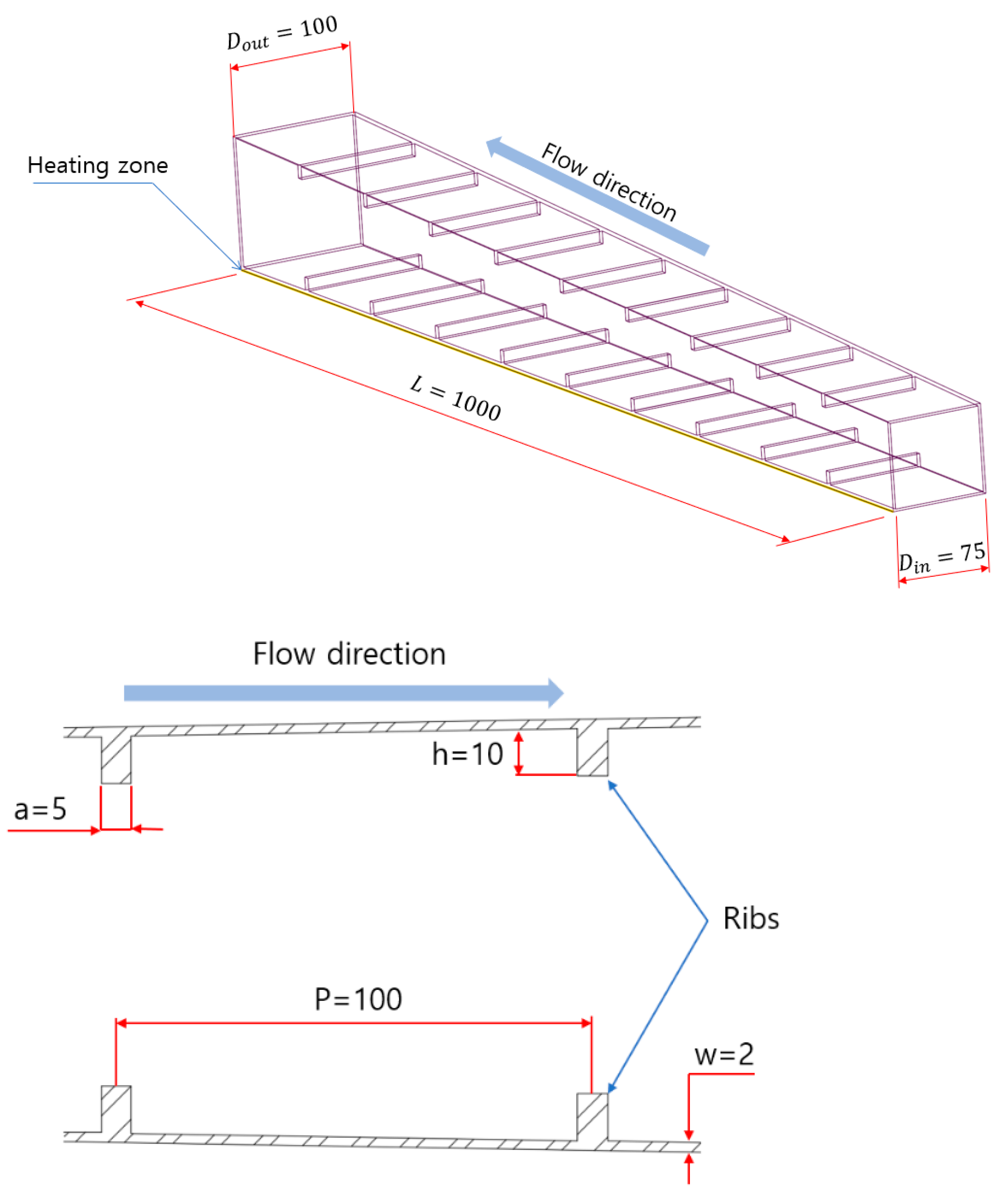
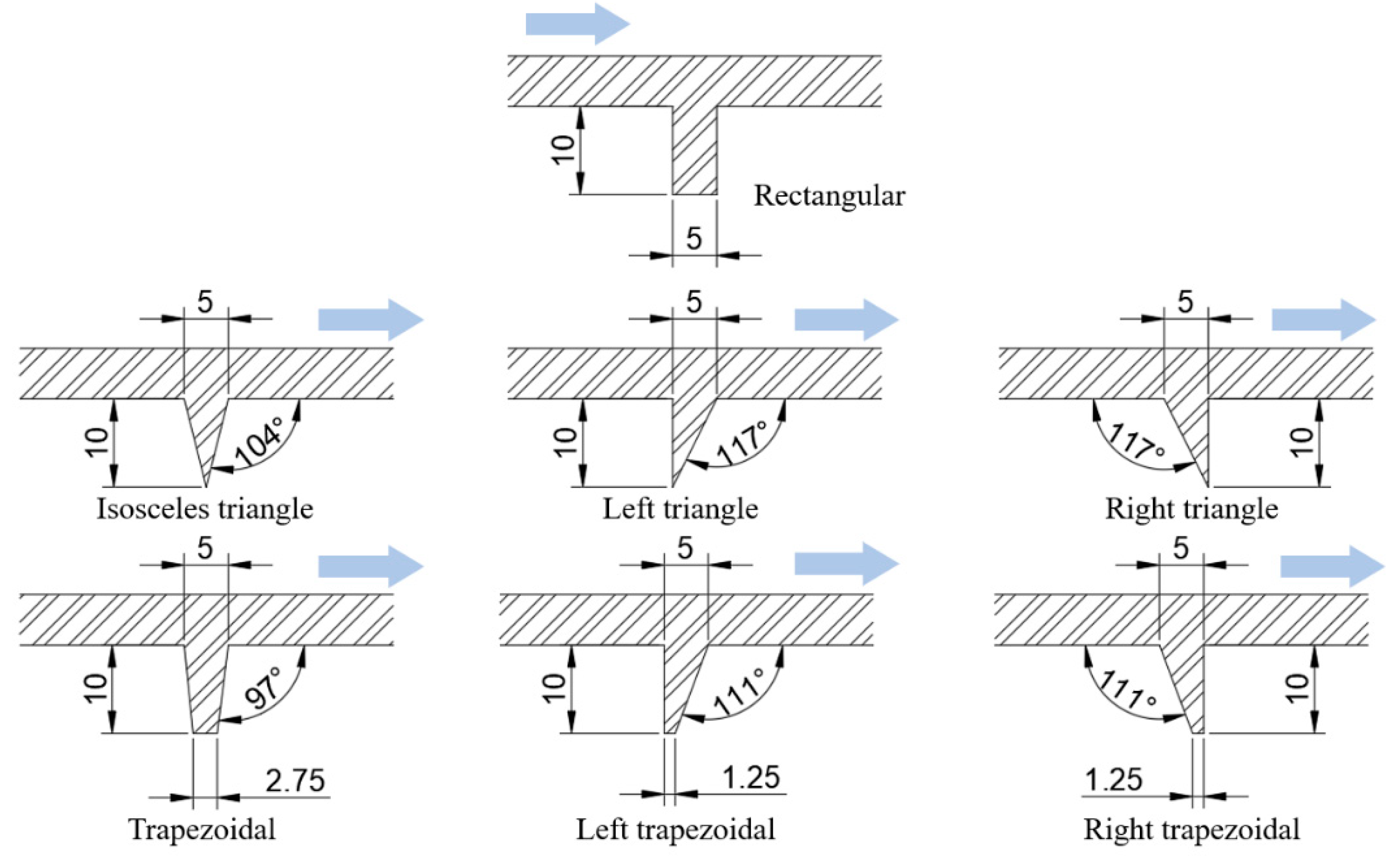
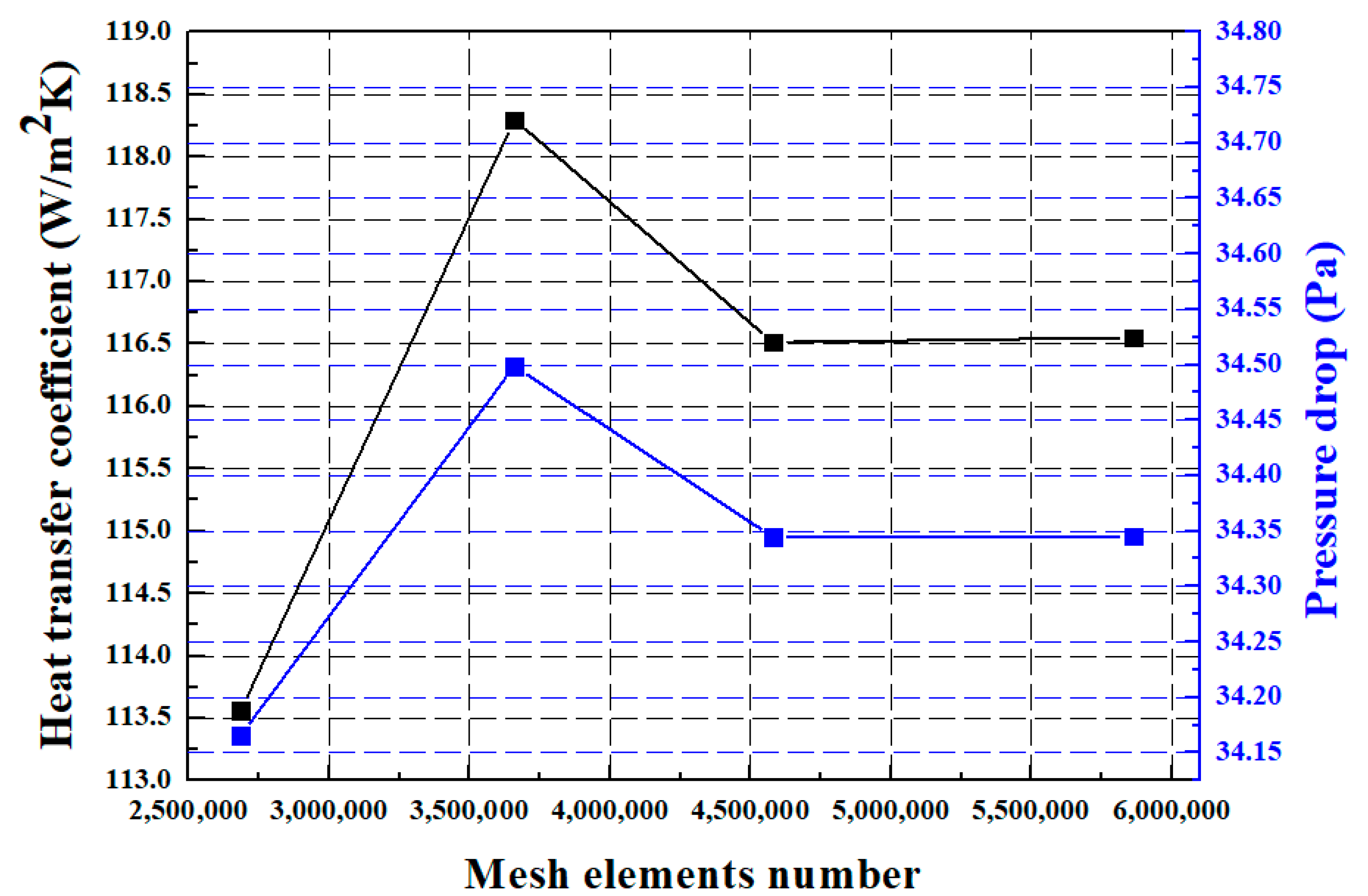
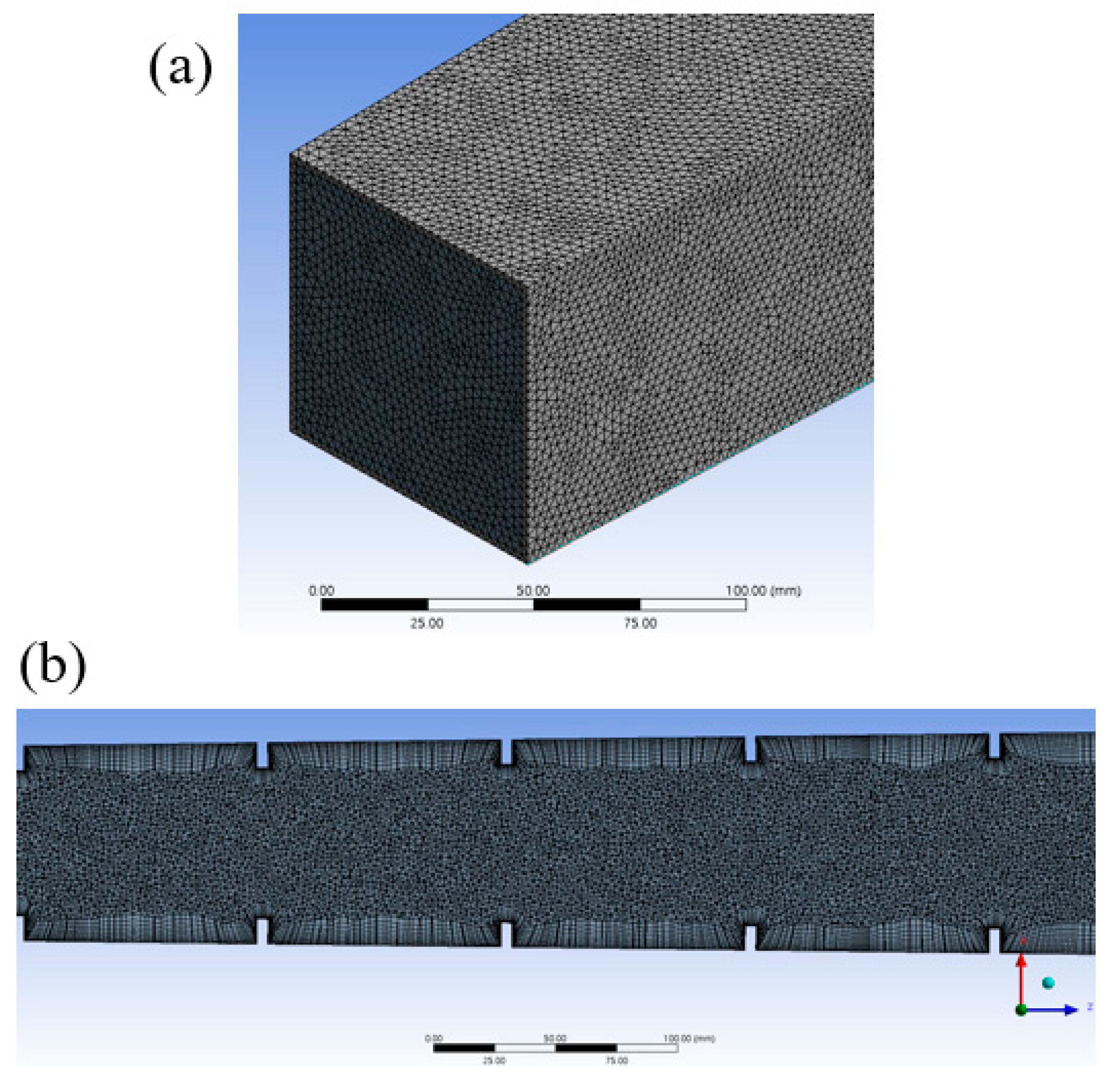

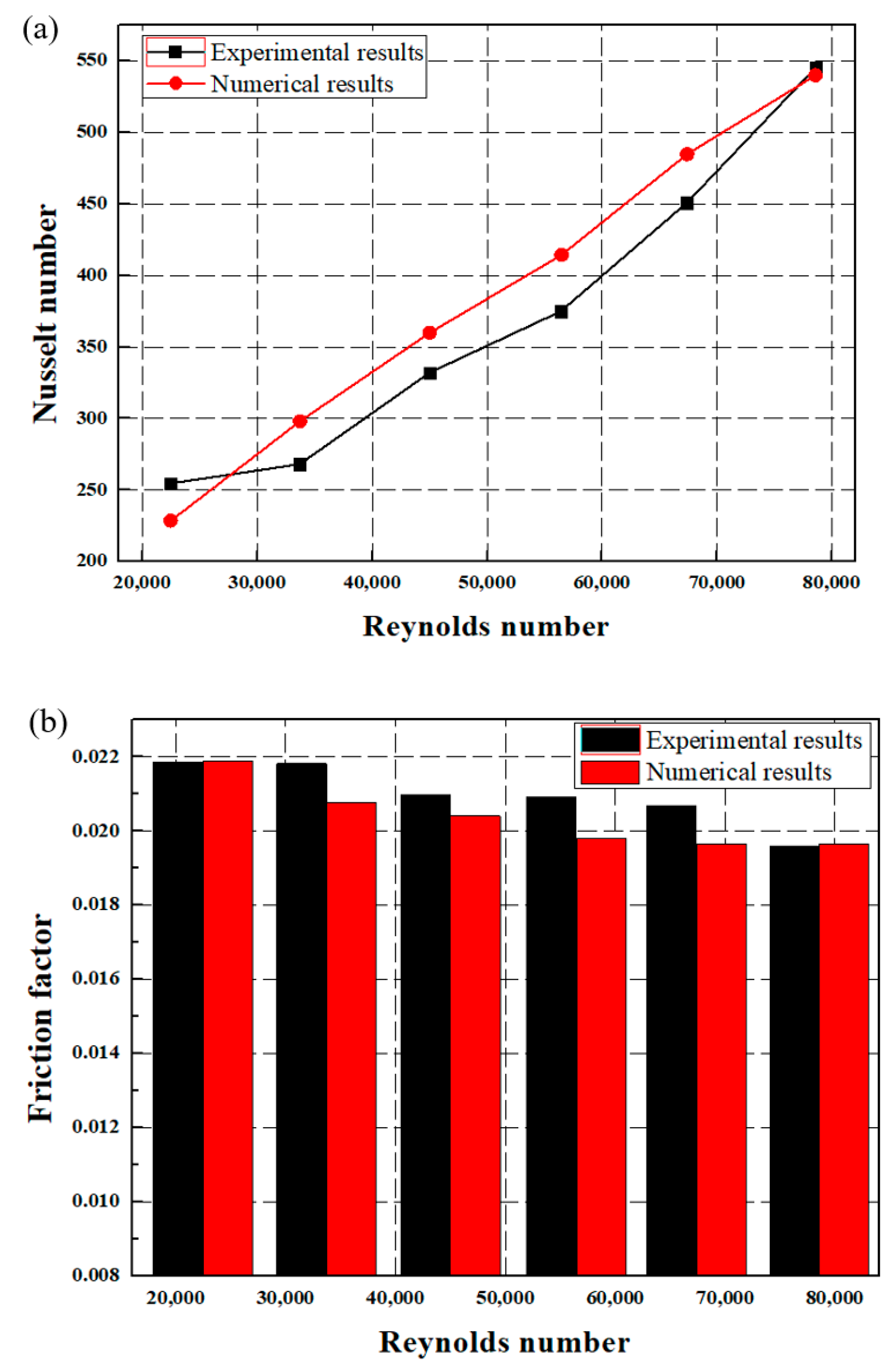

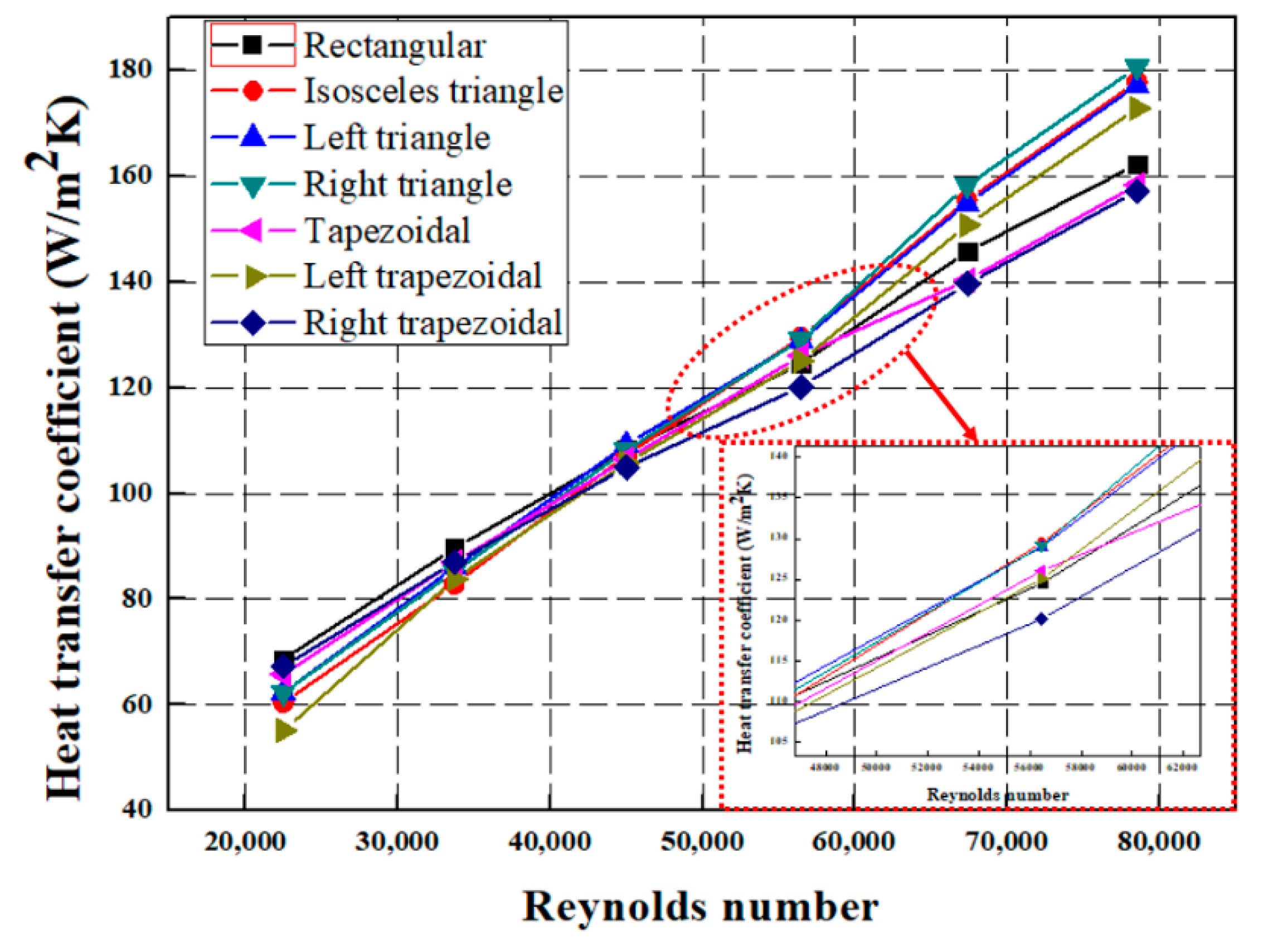


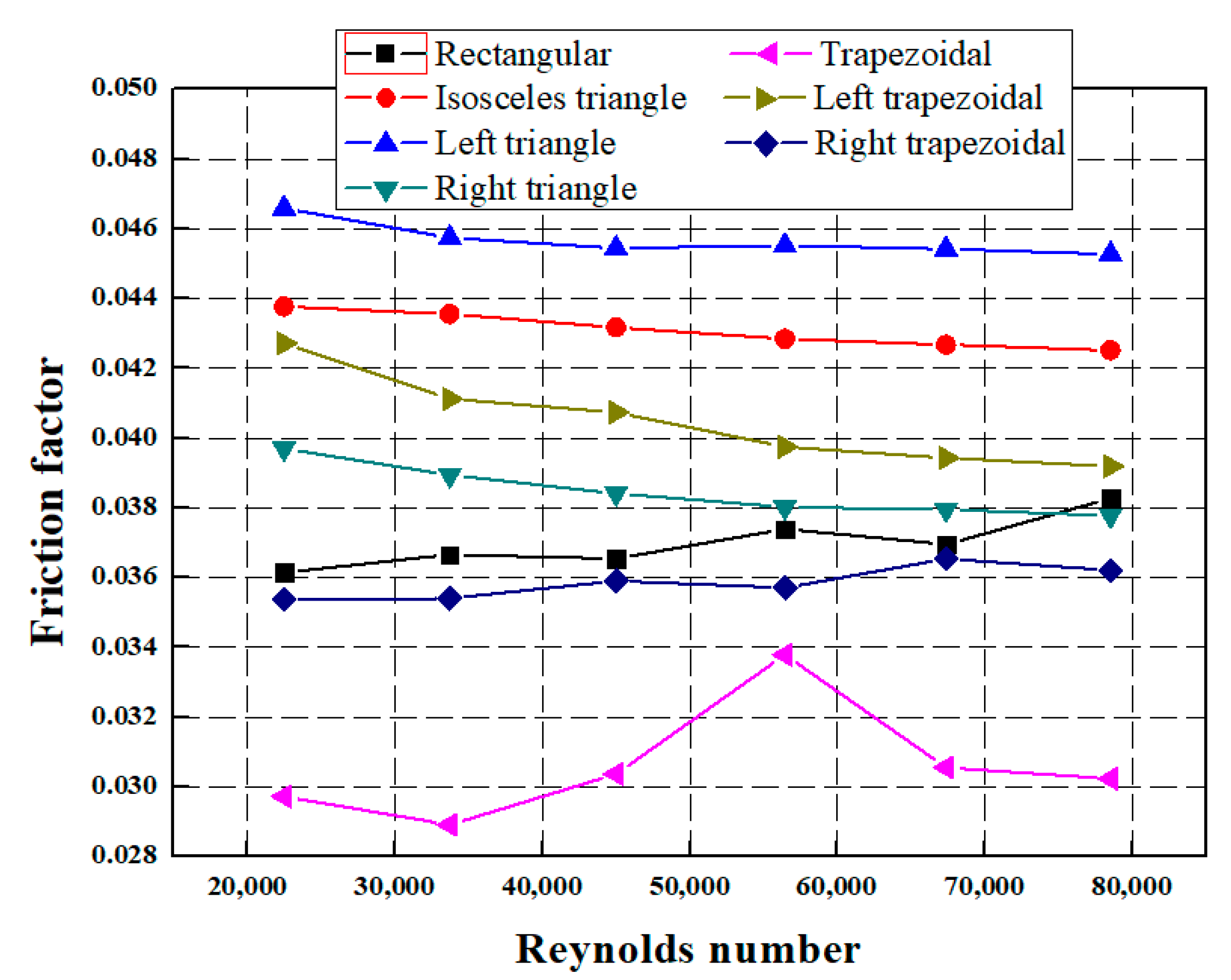
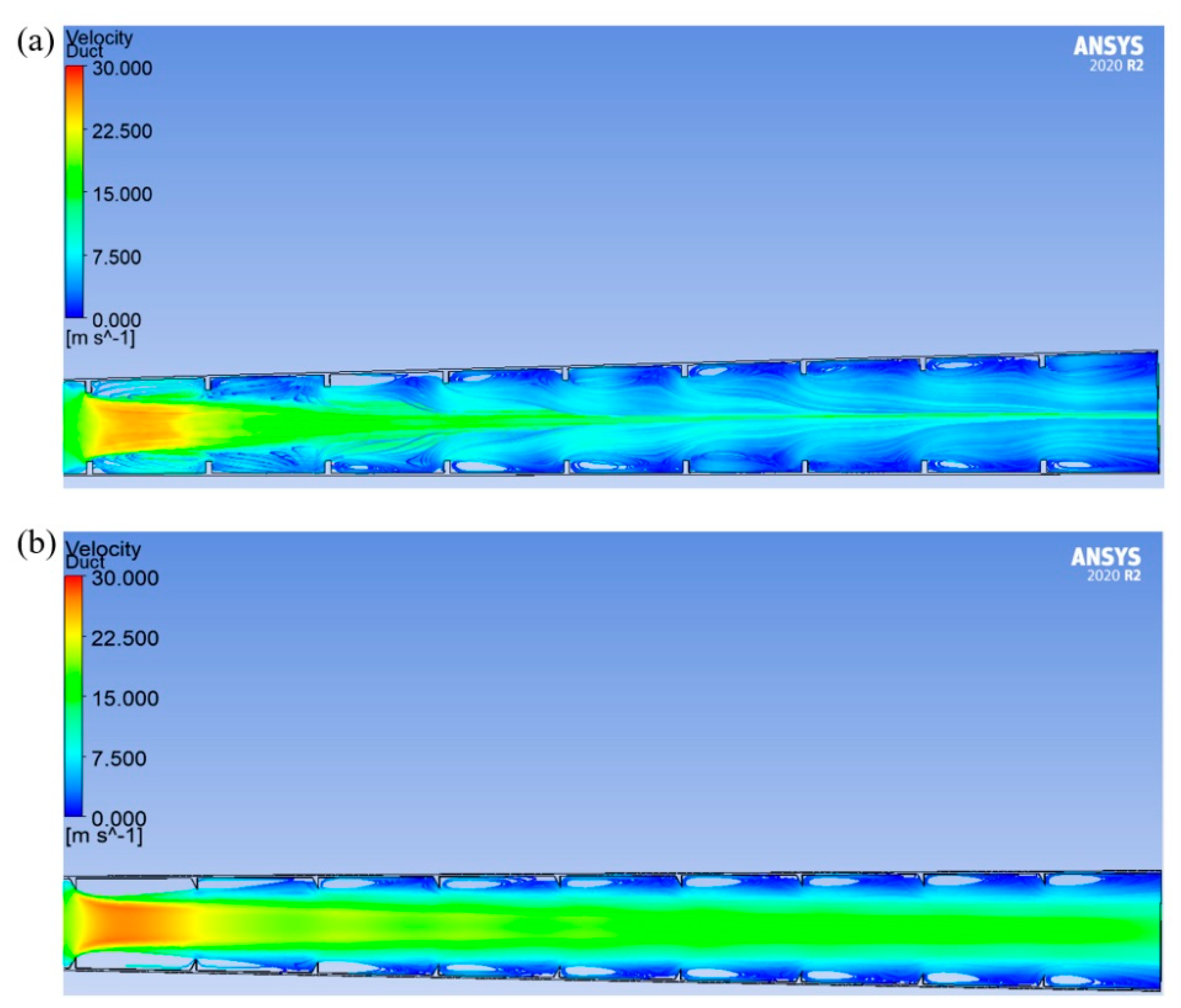
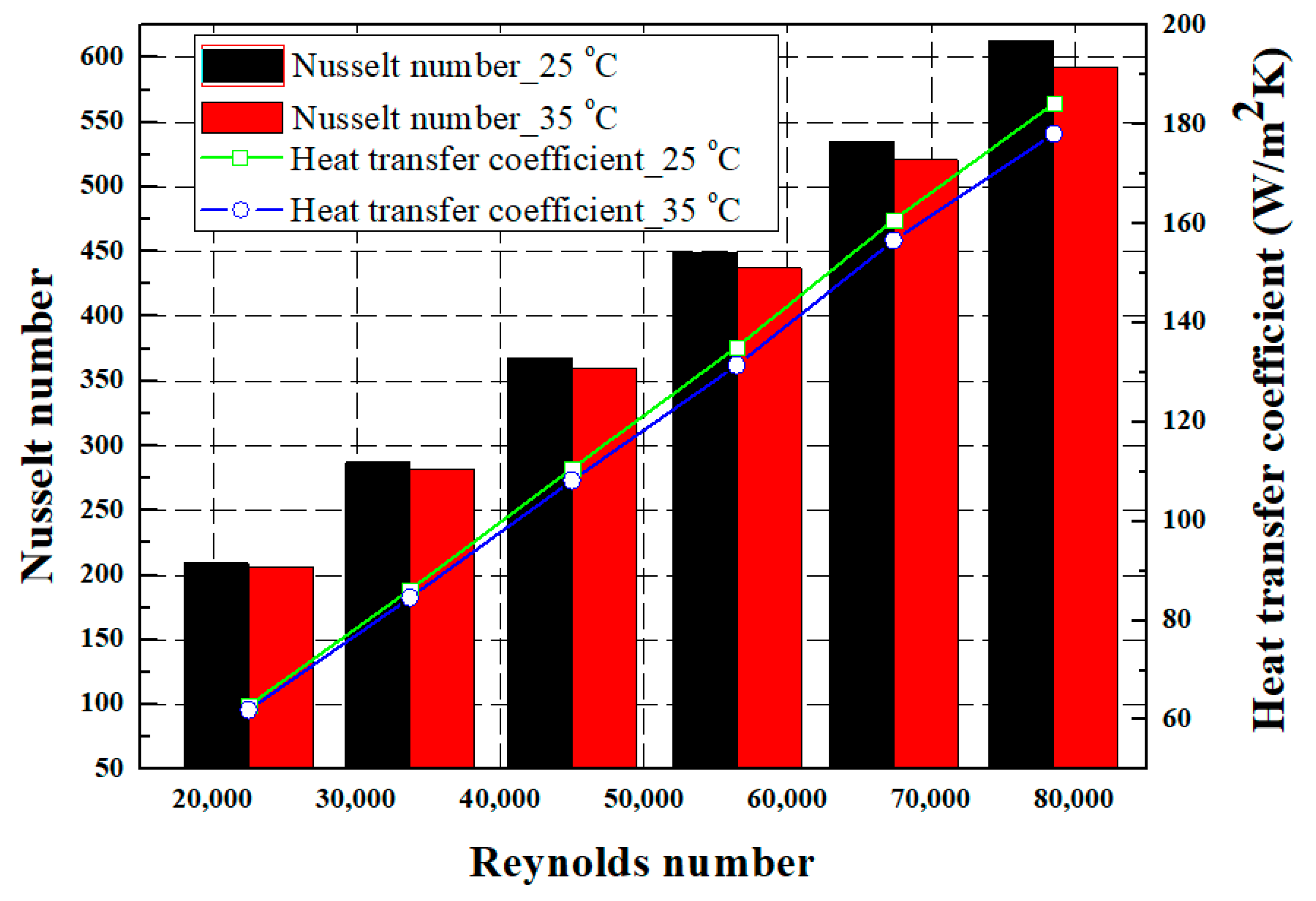
| Element Size | 2.3 mm | 2.5 mm | 2.7 mm | 3 mm |
|---|---|---|---|---|
| Number of elements | 5,862,872 | 4,579,698 | 3,659,611 | 2,684,802 |
| Property | Air | Copper |
|---|---|---|
| Density (kg/m3) | 1.164 | 8933 |
| Specific heat (J/kg∙K) | 1007 | 385 |
| Thermal conductivity (W/m∙K) | 0.02588 | 400 |
| Viscosity (Pa∙s) | - |
Publisher’s Note: MDPI stays neutral with regard to jurisdictional claims in published maps and institutional affiliations. |
© 2022 by the authors. Licensee MDPI, Basel, Switzerland. This article is an open access article distributed under the terms and conditions of the Creative Commons Attribution (CC BY) license (https://creativecommons.org/licenses/by/4.0/).
Share and Cite
Garud, K.S.; Kudriavskyi, Y.; Lee, M.-S.; Kang, E.-H.; Lee, M.-Y. Numerical Study on Thermal and Flow Characteristics of Divergent Duct with Different Rib Shapes for Electric-Vehicle Cooling System. Symmetry 2022, 14, 1696. https://doi.org/10.3390/sym14081696
Garud KS, Kudriavskyi Y, Lee M-S, Kang E-H, Lee M-Y. Numerical Study on Thermal and Flow Characteristics of Divergent Duct with Different Rib Shapes for Electric-Vehicle Cooling System. Symmetry. 2022; 14(8):1696. https://doi.org/10.3390/sym14081696
Chicago/Turabian StyleGarud, Kunal Sandip, Yurii Kudriavskyi, Myung-Sung Lee, Eun-Hyeok Kang, and Moo-Yeon Lee. 2022. "Numerical Study on Thermal and Flow Characteristics of Divergent Duct with Different Rib Shapes for Electric-Vehicle Cooling System" Symmetry 14, no. 8: 1696. https://doi.org/10.3390/sym14081696







